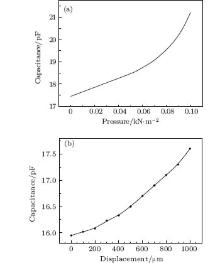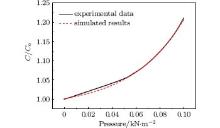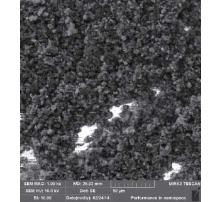Corresponding author. E-mail: zubairtarar@um.edu.my
Project supported by University Malaya Research Grant (Grant No. RP007A-13AFR).
We report newly designed pressure and displacement capacitive sensors based on a flexible paper–CNT structure. The carbon nanotube (CNT) powder was deposited on a thin paper substrate and was pressed at an elevated temperature. The sheet resistance of the paper–CNT films was in the range of 2–4 kΩ/cm2. The paper–CNT films were used to fabricate pressure and displacement sensors. The sensitivities of the pressure and the displacement sensors were found to be 17.3 pF·m2/kN and 0.93 10−3 pF/μm, respectively. The experimental results were compared with the simulated data and they found good agreement with each other.
At present, different kinds of pressure sensors and displacement transducers have been used in practical applications.[1, 2]However, still more research work in this area is required in order to find new potential materials and new approaches. This would allow us to improve the sensors’ characteristics, such as sensitivity, linearity, and stability, and decrease the cost. Among the organic materials, carbon nanotubes (CNTs) have exhibited interesting and diverse features that could be helpful to develop a future generation of the sensors.[3] On the basis of the carbon nanotubes, there have been a number of reports that show the fabrication of different sensing devices, such as gas, humidity, chemicals, strain, and displacement sensors.[4– 11] In particular, during the last few years, many CNT-based sensors have been investigated, [12– 16] which are very suitable for the flexible electronics. Sibinski et al.[17] described a miniaturized flexible temperature sensor based on polymer compositions filled with multi-walled carbon nanotubes and found that the CNTs behave as a semiconductor material. The surface-type Al/CNT/Al flexible temperature sensors were also designed, fabricated, and investigated by Saeed et al.[18] The resistance– temperature relationship of these devices also showed a semiconductive behavior.
The electromechanical sensors based on the composite of organic materials and CNTs were recently investigated.[19] Hu et al.[20] described the recent development in the field of CNT/polymer nanocomposite-based strain sensors. It was shown that these sensors are highly sensitive due to the specific conductivity of the composites, in particular, due to the presence of the internal conductive network formed by the CNTs and the tunneling effect of the transfer of charge. Shang et al.[21] reported that a composite of multi-walled carbon nanotubes (MWNTs) and polyurethane can be used for the fabrication of an elastic conductive nanocomposite. Several other investigations have also been reported on the CNT-based pressure, strain, and displacement sensors.[10, 11, 22] It was found that highly sensitive CNT-based pressure, strain, and displacement sensors can be fabricated which also exhibit a prompt response. Wang et al.[23] developed a model to investigate the the elastic buckling of individual MWNTs under radial pressure. That model explains that the CNTs turn their properties from metallic to semiconducting under radial pressure until certain critical twisting angles. Wu et al.[24] investigated the effect of nanofillers such as multi-walled carbon nanotube and vapor-grown carbon fiber (VGCF) to improve the piezoelectricity in a polymer. They found that the nanofiller increases this transformation because the nanofiller provides a phase transformation nucleation function. Some more works that explore the changes of permittivity with the addition of CNTs to polymers have been discussed in a recent work by Wuet al.[25] The properties of CNT-based strain and displacement sensors have also been discussed by Karimov et al.[10, 11]
In continuation of our previous work, in this paper, an investigation of the novel pressure and displacement capacitive sensors based on the flexible CNT is reported. These sensors have potential advantages such as low cost and high flexibility. We believe that these sensors could be used for more attractive and innovative applications, especially for large area flexible electronics.
An 80-μ m thick normal printing paper was used as the flexible substrate. Commercially produced (Sun Nanotech Co Ltd., China) multi-walled nanotube powder was used in the fabrication of the sensors. The diameter of the CNTs was in the range of 10– 30 nm. For the fabrication of the sensors, the CNT powder was uniformly deposited on the paper substrate to make paper– CNT samples. The sample size was 30 mm × 23 mm. The CNT layer was pressed at a pressure of 3– 5 kN· m− 2 at temperature 90– 100 ° C for 20– 30 s. Figure 1 shows SEM images of the CNT layers deposited on the paper. The sheet resistance of the paper– CNT samples was in the range of 2– 4 kΩ /cm2. Figure 2 shows the schematic diagram of the paper– CNT pressure and displacement capacitive sensors. The moving mechanism (vii) allowed the estimation of either pressure or displacement. Initially, the distance between the plates of the capacitive sensor (distance between flexible CNT composite and metallic foil) was equal to 1.5– 2 mm. The capacitance was measured at 1 kHz by an MT 4090 LCR meter under standard environmental conditions.
Figure 3(a) shows the capacitance– pressure relationship of the paper– CNT-based sensor, whereas figure 3(b) shows the capacitance– displacement relationship of the sensor. It is observed that the capacitance increases with an increase in the pressure or a decrease in the gap between the electrodes. This change in the capacitance is due to the change of the geometrical parameters under the applied pressure and the change in the displacement. The working principle of the sensors can be explained as follows. By bending the flexible CNT composite film, the average distance between the plates of the capacitance is decreased due to the moving mechanism. As a result, the capacitance should increase, which is related to the increase of the pressure or the displacement. The change in the capacitance of a parallel-plate flexible capacitor is related to the changes in the thickness and the area of the plates. The relation between the change in the capacitance and the changes of the thickness, the area of the plates, and the relative permittivity can be expressed as[26]
 | Fig. 3. (a) Capacitance– pressure relationship of the paper– CNT-based sensor. (b) Capacitance– displacement relationship of the paper– CNT-based sensor. |
 |
where Δ C is the change in the capacitance, Δ d is the change in the thickness, Δ ε is the change in the permittivity, and Δ A is the change in the area under the applied pressure or due to the change in the displacement. The change in the geometry is represented by Δ d/d and Δ A/A, whereas the change in the permittivity is represented by Δ ε /ε . Actually, the CNT composite (built-in paper) plays the role of a conductive flexible plate of the capacitor. That is why the permittivity of the capacitor is constant (equal to the permittivity of the air). Therefore only the contribution of the change in the geometry in the pressure sensor should be considered rather than the change in the permittivity. In this case, the deformation in the electrodes is significant. The Δ d/d term presents that the electrodes are deformable, where Δ d can be determined by the bending in the shape of the sensor.
The pressure sensitivity Sp and the displacement sensitivity SD of the sensors can be expressed by the following expressions:[27]
 |
 |
where Δ C, p, and D are the capacitance change, the pressure, and the displacement, respectively. The sensitivity is 17.3 pF m2/kN for the pressure sensors and 0.93 10− 3pF/μ m for the displacement sensors. The average increases of the capacitances of the pressure and the displacement sensors are 22%– 24% and 6%– 10% with increasing pressure and displacement up to 0.135 kN/m2 and 1000 μ m, respectively. It is seen that the sensors are sensitive to very low values of pressure and displacement. If C is the initial capacitance of the device, Cben is the bending capacitance as a result of the bending of the flexible substrate. The Cben can be replaced in the first-order approximation by an equivalent capacitance with flat plates (Ceq). In this case, the simulation of the experimental results in the capacitance– pressure/displacement relationships can be realized by the use of the following formula:[28]
 |
where ε is a relative dielectric constant (ε = 1 for air), ε o is the absolute permittivity, A is the area of the plate, and d is the distance between the plates of the capacitor. Under the effect of pressure p, the distance between the plates decreases and the area to some extent increases (Fig. 2(c)). The capacitance under pressure p can be represented by the following expression:
 |
where k1 and k2 are fitting parameters for the area and the distance. In relative values, equation (5) can be rewritten as
 |
By using the first-order approximation, equation (6) can be simplified as
 |
As seen from the experimental data in Fig. 3(a), the capacitance has an exponential relation with the pressure. Therefore equation (7) can be modified as
 |
where C and Co are the capacitances of the sensor under pressure p and at initial condition, respectively. Here a = 1, b = 0.532 m2/kN, and c = 22.8 m2/kN. The modification of Eq. (7) to Eq. (8) is done corresponding to the experimental results. The overall shape of the capacitive sensor is nonlinear. Figure 4 shows the simulated results using Eq. (8). It seems in good agreement with the experimental results. The exponential change in the capacitance may be due to the mechanical properties of the composite film.
 | Fig. 4. Experimental and simulated results for the capacitance– pressure relationship of the paper– CNT composite pressure sensor. |
In fact, in the disordered systems, the charge transport is observed between randomly distributed sites.[29, 30] Charge hops out from one localized state to another and contributes to the conductivity. The conductivity of the charge in a random geometry is described by the percolation theory. According to the theory, the average conductivity of the paper– CNT composite can be estimated using the expression[29, 30]
 |
where L is the characteristic length between the sites, and Z is the average resistance of the connecting path between the sites. Based on the CNT composite, the investigated pressure and displacement sensors potentially can be developed for utilization in medicine, environmental parameters’ assessment, and industry.
The fabrication and properties of pressure and displacement capacitive sensors based on paper– CNT are presented. The flexible active films play the role of one of the plates of the capacitance. It is found that the pressure and the displacement capacitive sensors have sufficiently good response and potentially can be used in practical applications.
| 1 |
|
| 2 |
|
| 3 |
|
| 4 |
|
| 5 |
|
| 6 |
|
| 7 |
|
| 8 |
|
| 9 |
|
| 10 |
|
| 11 |
|
| 12 |
|
| 13 |
|
| 14 |
|
| 15 |
|
| 16 |
|
| 17 |
|
| 18 |
|
| 19 |
|
| 20 |
|
| 21 |
|
| 22 |
|
| 23 |
|
| 24 |
|
| 25 |
|
| 26 |
|
| 27 |
|
| 28 |
|
| 29 |
|
| 30 |
|



